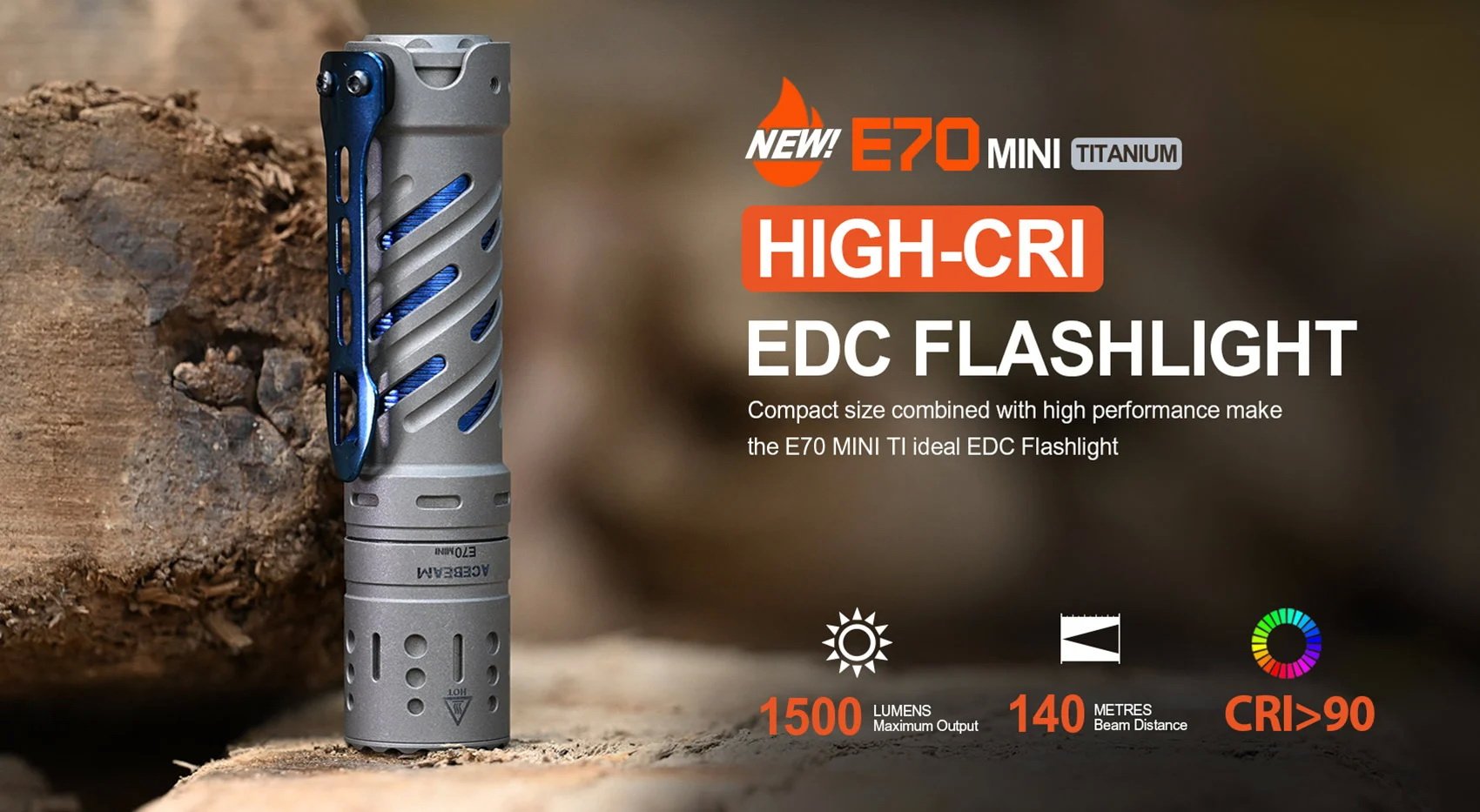Introduction
It's been more than a year since I reviewed the excellent Acebeam E70 and Acebeam E70 Ti CRI95+ and in the meantime Acebeam released a mini version, which is easier to EDC but seems to be just as impressive. Being partial to Titanium, despite its thermal inefficiency, I decided to review the Titanium version of the light, the Acebeam E70 Mini Ti.

The design of the Acebeam E70 Mini Ti is almost identical to its larger predecessor, but as you will see there are some key differences.
Unboxing
The Acebeam E70 Mini Ti comes in a white box with a clear window that allows a view of the light.
The back side of the box does not offer any more information or specifications, but rather the company address, a few QR coded links and the usual certification logos.


The top and bottom of the box are plain white, so nothing to show. One of the longer sides emphasizes the 5 year warranty while the other features the company logo.


Inside the box we find the Acebeam E70 Mini Ti nested in protective clear plastic.

The accessories include a USB A to USB C charging cable, 2 spare O-rings and a lanyard. The leaflets include the manual, a warranty card and a yellow card picturing that the battery is in the light and the insulation sheet needs to be removed before use and also showing the operating instructions.

One side of the manual leaflet is in Chinese and the other is in English. Here is the English side.

And this is the warranty card.


The Acebeam E70 Mini Ti features the same design as the E70, which is very harmonious and pleasing to the eye.


The bezel is crenulated and the head features alternating circular and oblong designs, which work well together. The 6 oblong grooves can accommodate 6mm x 1.5mm tritium vials.

The body of the torch features a helix design, with cut outs revealing the inner tube and creating a beautiful visual effect. It also features 6 oblong grooves where it connects to the head that can accommodate 6mm x 1.5mm tritium vials.


The tail part of the tube features tapped holes where the clip comes pre-attached. The clip is made of steel and anodized blue, like the inner tube.
There are 3 sections at the back end of the body. One with the clip installed, one with tapped holes, where the clip could be moved to - no idea why though - and one with bigger holes, where the lanyard can be installed. Installing the lanyard is not easy and requires thin tweezers.




In total, the Acebeam E70 Mini Ti features an intricate design which looks quite busy but still harmonious and pleasing to the eye. The machining of such a design is not an easy feat, especially in Titanium and with the level of detail and quality we see here.

The business end of the torch comes with a protective plastic film, which must be removed before use.
Under the protective film, we can see a Carclo optic, covering the 3 emitters. Yes, unlike its larger predecessor, the Acebeam E70 Mini Ti is a triple.


The back end of the torch is quite simple. It is where the stainless steel, blue anodized switch for the operation of the torch is located. I like the simple, recessed design of the switch which allows the torch to tail stand and helps to protect from accidental activation. Clicking the switch is both easy and satisfying, without too much resistance but with adequate feedback.

The head and body unscrew to reveal that the battery ships inside the light, with the positive terminal insulated for safety. The threads are thick, square cut and nicely lubricated, but still rather gritty.


The battery is an Acebeam branded 18650 Li-Ion battery, rated at 3100mAh and it features a USB C charging port near the positive terminal.


Both battery contacts feature thick, good quality springs. Having springs on both ends makes the torch resilient to bumps and drops, as the battery is suspended between two springs under pressure and is not likely to momentarily disconnect and turn the light off.
As mentioned before, there is an inner tube, as the light features an electronic switch at the back and both the negative terminal of the battery and the switch need to be connected to the driver. On the driver end, there are two concentric contact rings. The outer ring contacts the outer tube of the tail part and connects to the battery negative and the inner ring connects to the inner tube and transfers the switch presses. The spring in the middle of the driver makes direct contact with the positive terminal of the battery.


Installing tritium vials is pretty straight forward, as the grooves are perfectly sized and deep enough.


Quality
The machining quality of the Acebeam E70 Mini Ti is very high. Even at close inspection, there are no flaws.


No edge is sharp, not a single spot less than perfectly milled. This is indeed a top quality light.

Specifications
The specifications of the Acebeam E70 Mini Ti can be seen in the following table:

Unlike the E70, the Acebeam E70 Mini Ti comes only in a high CRI option, utilizing 3 Nichia 519a emitters at 5000K. Despite being high CRI, the Acebeam E70 Mini Ti claims a maximum output of 1500 Lumens (the aluminium version goes even higher, at 2000 Lumens) and a throw of 140m.

The high CRI emitters render colours much more naturally and make everything look more vibrant and pleasing to the eye.

The Acebeam E70 Mini Ti is water and dust proof in accordance with IP68 specs, which makes it submersible to 2m. It is also impact resistant up to 1m.

User Interface
The user interface of the Acebeam E70 Mini Ti is simple and intuitive.

Despite featuring a recessed button, and a lock mode, a double click is required to turn the light on. This prevents accidental activation of unlocked lights and protects even the most careless of users from accidental activations, which could be disastrous with such a powerful light.
The included card has detailed instructions on the user interface.

The user interface of the Acebeam E70 Mini Ti, in my own words, is as follows:
-
From Off
- Double click to turn on (with memory for the 4 main modes), click again to turn off.
- Click and hold from off to turn on at Moonlight mode. Keep holding until if flashes three times to lock the light. Click and hold again to unlock into Moonlight mode.
- Triple click for Strobe. Click to turn off, click and hold to go to low and cycle through the main modes or double click for Turbo.
-
From On
- Click to turn off.
- Hold to cycle through the main modes (Low, Mid1 ,Mid2, High).
- Double click for Turbo. Double click again to return to previous mode.
- Triple click for Strobe. Click to turn off, click and hold to cycle through the main modes or double click for Turbo. From Turbo, double click to return to previous (before Strobe) mode. There is no way to go directly from Strobe to a previous, non Turbo mode.
Modes
The output of the Acebeam E70 Mini Ti can be seen in the following table. In black are the output numbers provided by Acebeam and in orange are my measurements. My Lumen measurements show that Ultra-Low, Low and Turbo are spot on while Mid1, Mid 2 and High are a bit lower than spec. Of course, my enthusiast amateur equipment is far from accurate and can easily be up to 10% off, so take this with a grain of salt.
The Candela and Throw I measured are significantly lower than claimed, but still very respectable for a floody EDC torch.

Size Comparison
Size wise, the Acebeam E70 Mini Ti is as expected for a triple 18650 powered torch with inner tube and tail switch. It is of course larger than the single emitter Olight Warrior Mini which solves the tail switch signal transfer issue with a proprietary battery rather than an inner tube and is therefore very compact.


Photometry
I took some photometry readings with an Opple Light Master Pro. The results are in the following table.

The Acebeam E70 Mini Ti is consistently warmer than the claimed 5000K, which is nice and the CRI is definitely higher than 90. The Duv is a little above BBL, fairly neutral albeit slightly on the green side on all modes except Turbo where it dips below BBL and becomes nicely rosy.
That said, it is quite a nice tint and much more pleasant than the tint of the Olight Warrior Mini, even on Low, where the Acebeam E70 Mini Ti is at its greenest. The photo below was taken with the Acebeam E70 Mini Ti on Low and the white balance locked at 5500K.

Beam Profile
The beam pattern of the Acebeam E70 Mini Ti is as expected from 3 Nichia 519a emitters behind a Carclo optic. It is quite uniform and floody, with a well defined, large hot spot and a lot of spill.

Beam Shots
I tested the Acebeam E70 Mini Ti outside, over a distance of 70m.

The following video shows a comparison of the Acebeam E70 Mini Ti with the Olight Warrior Mini Winter. The two torches have the same maximum output of 1500 Lumens, are both made of Titanium and have roughly the same cost. The Warrior Mini has a narrower beam profile, with more throw and is much greener and low CRI.
Driver
The driver of the Acebeam E70 Mini Ti is a digitally regulated, constant current boost driver, which powers the 3 in a row Nichia 519a emitters and should be able to maintain constant brightness regardless of the battery voltage. It features smart temperature control, reverse polarity protection and low voltage protection. Very refreshing to see such a high quality driver.

There is no visible PWM in any of the modes.








Current Draw
The following table shows the current draw of the Acebeam E70 Mini Ti, using the included battery.

Battery and Charging
The battery included with the Acebeam E70 Mini Ti is a 18650, rated at 3100mAh and features onboard USB C charging.


The specifications of the Acebeam ARC18650H-310A with built-in USB port, as shown on the company's website, are listed in the following table:

I measured the capacity of the battery at exactly 3046mAh which just shy of the 3100mAh rated capacity. The battery's internal resistance was measured at 31mΩ. The light has Low Voltage Protection and turns off when the battery voltage drops to 2.74V.
Charging the Acebeam ARC18650H-310A with built-in USB port is very easy. Just connect the provided cable or any other USB C cable to the charging port and its other end to a charger. Both USB A to USB C and USB C to USB C cables can be used as well as any charger, including the ones that support PD. This is very convenient as you can charge the Acebeam ARC18650H-310A with built-in USB port with any USB C cable and charger you have at hand. The LED on the battery lights up red to indicate that it is charging and turns green when the charging is completed, at 4.19V.


The Acebeam ARC18650H-310A with built-in USB port took 2 hours, 30 minutes and 22 seconds to charge from 2.74V to 4.19V. The maximum current drawn was 1.3708A, which is great for a 18650 battery.

Runtime Charts
The Acebeam E70 Mini Ti is rated at a maximum of 1500 Lumens.
I do not own a multi thousand dollar worth integrating sphere, just a logging Lumen meter and a home made integrating tube. The array is calibrated with 3 separate, professionally measured lights and gives me consistent results, but there is definitely room for error and deviations are to be expected.
According to my measurements, the maximum output (at turn on) was 1525 Lumens, which slightly exceeds the declared 1500 Lumens. ANSI output (at 30 seconds) was 1385 Lumens and the gradual output decline continued down to 1295 Lumens at 1 minute and 8 seconds. It then declined rapidly over the next 13 seconds to 314 Lumens and quickly recovered a bit to 326 Lumens, where it stayed very stable for 2 hours 45 minutes and 12 seconds. Then it dropped to 149 Lumens for 8 minutes and 28 seconds and then to 62 Lumens for 15 minutes and 46 seconds. Finally, it dropped to 25 Lumens for a further 55 minutes and 7 seconds, before it turned off.
The titanium construction of the Acebeam E70 Mini Ti coupled with the use of high CRI emitters make for some high temperatures that momentarily reached up to almost 65°C at the head of the light. Thankfully the same poor thermal properties of Titanium kept the body relatively cool, at below 43°C throughout the runtime test.

Here are the first 10 minutes of the Turbo Runtime Chart, in greater detail.

The behaviour of the Acebeam E70 Mini Ti is similar on High mode. Here is the full Runtime Chart on High mode.

And here are the first 10 minutes of the Acebeam E70 Mini Ti High mode Runtime Chart, in greater detail.

Conclusion
The Acebeam E70 Mini Ti is a light that emphasizes quality.
The machining of the Titanium host is intricate with no imperfections or sharp edges. The driver is fully regulated and provides constant current output without any visible PWM on any of the modes. The Nichia 519A 5000K emitters produce a neutral, floody beam with a very pleasant tint and fantastic colour rendition.
The User Interface is simple and intuitive and extra care has been taken to prevent accidental activations.
The size is normal for a 18650 light and can be easily carried in a pocket, even though there are definitely smaller 18650 torches available.
The included Acebeam ARC18650H-310A with built-in USB port battery features USB C onboard charging which takes about 2.5 hours from depleted to full and makes the use of a dedicated charger optional.

If you are looking for a premium quality torch that feels luxurious to hold and produces light equally as luxurious to look at, then the Acebeam E70 Mini Ti is a light you should consider.
The Acebeam E70 Mini Ti can be purchased directly from the company's website and the cost at the moment this review is written is $109.90, including the battery and shipping, worldwide. It is also available from Amazon.de at a great price deal for Amazon Prime members.
Let's list the Pros and Cons of the Acebeam E70 Mini Ti:

Pros
+ Neutral 5000K high CRI emitters produce excellent light quality.
+ Digitally regulated constant current boost driver which provides stable output and high efficiency with no visible PWM.
+ Luxurious Titanium Body construction.
+ Long runtimes.
+ Impeccable and intricate machining.
+ USB type C charging integrated in the included battery.
+ Low Voltage Protection.
+ Quality springs on both sides of the battery.
+ Smart Temperature Control.
+ Simple and intuitive UI.
+ 12 slots for 6mm x 1.5mm tritium vials.
+ IP68.

Cons
- I measured the throw to be lower than advertised.
- The Ultra-Low mode is 12 Lumens. A 1 Lumen or even sub-Lumen mode would have been nicer.
Thanks to Acebeam for providing the sample for review

Polymeros Achaniotis 11/10/2022
-
 9
9








Recommended Comments
Create an account or sign in to comment
You need to be a member in order to leave a comment
Create an account
Sign up for a new account in our community. It's easy!
Register a new accountSign in
Already have an account? Sign in here.
Sign In Now